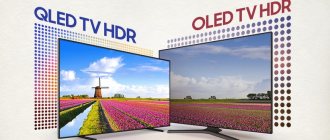4K resolution
Revolution in resolution: Xbox One S renders all its games in 4K, thanks to surprisingly good built-in upscaling. PS4 Pro also outputs games in 4K using a combination of upscaling and in-game enhancements. The Xbox One X is so powerful that it can play games with 4K support built into the engine. Yes, you may not have 4K Xbox One and PS4 consoles. And yes, games that don't support 4K resolution will need to be upscaled on a 4K TV, so won't be completely clean. But right now, the best 4K TVs do a great job of upscaling, without significantly delaying the time it takes for the TV to render images.
HDR
Very close to 4K in the modern video world is high dynamic range (HDR) technology. It provides images with a much wider range of brightness than the standard dynamic range images we've lived with for decades. HDR attempts to provide images on screens that more closely resemble how our eyes see the real world.
Xbox One S supports HDR in games and streaming apps. The same situation applies to PS4 and PS4 Pro, and naturally the Xbox One X also offers HDR playback. Most people will say that HDR performs much better than 4K, especially on smaller screens.
The only problem is that HDR puts a lot of stress on the TV, requiring extra brightness and deeper blacks at the same time. In fact, a poorly done HDR can look worse than a decently done SDR. This is worth considering if you are thinking about buying a very cheap TV.
One of the most important elements of good HDR reproduction is brightness. Many movies and games target 1000 nits or so for bright elements, so if you have a TV with lower brightness, it won't capture the full potential of HDR. Especially in video games where the graphics can be sharper in contrasting conditions than "real life".
It's entirely possible for TVs to deliver great HDR pictures without reaching 1000 nits or higher brightness. This is especially true for, for example, OLED screens. But the darker the screen, the more difficult it will be to process image information in HDR areas beyond the screen's capabilities.
Important TV Features for Gaming
The concept of a gaming TV appeared quite recently. Until this time, the only monopolist in the gaming industry was monitors. They were not distinguished by high clarity and brightness of images; they had and still have low viewing angles. The monitors provided frame changes with a maximum frequency of 160-240 Hz and minimal output latency.
On TVs, including those suitable for consoles, high-quality images come first, and all parameters needed for normal games are paid separately. In any case, TVs will cost significantly more than any monitor, since they have an expanded range of technical characteristics.
4k resolution
Modern game consoles, including PlayStation, Xbox and others, after many updates and improvements, are capable of working with 4K resolution and the HDR function. All the features of new games are now displayed on the big screen.
This is made possible by built-in scaling and numerous improvements to the games themselves. The performance of consoles with a built-in engine ensures support and maximum transmission of images on a 4K resolution screen. Even if the set-top box does not support such a resolution, a modern high-quality TV itself will cope with this task without noticeable time delays.
HDR
Along with 4K resolution, modern television has received such a useful feature as HDR. Its acronym stands for wide dynamic range, and the technology itself is designed for advanced brightness settings. Due to this, the broadcast of images is much higher quality compared to conventional TV. The picture turns out to be as realistic as possible, similar to a living reflection of reality perceived by sight.
The Xbox One S is fully HDR compatible, supporting games and streaming applications. The same compatibility applies to Xbox One X, PS4 and PS4 Pro consoles. In terms of performance, this function significantly exceeds 4K, especially on monitors with small diagonals.
Panel types
Then you can consider additional bits and features that enhance the games. First up is the panel type: most are edge-lit LED panels, and most come with HDR as standard so will display images with acceptable color, contrast and sharpness. Those who want brighter images (for colorful games like Assassin's Creed Odyssey) should definitely consider Samsung's QLED models, which are brighter than any other panel. If contrast and true blacks are important to you, and you're a fan of games like Metro: Exodus, then you might want to look at OLED panels. There are many manufacturers, but LG screens are the best here.
If you can't afford the most expensive TVs, then look at TVs with high refresh rates and acceptable response times. The best 4K HDR TVs have input lag of around 20ms or less, mid-range models around 30ms, and slower screens respond in 40ms or more. Typically, a difference of about 15 ms between the two screens is already noticeable. Look for TVs with a gaming mode that allows for fast response speeds. If you're a really serious gamer, especially when it comes to reaction-based online games, you'll need to take care of input lag: the time it takes for a particular TV to display the image data received at its inputs. Obviously, you'll be looking for low values unless you want to get shot by an enemy your TV hasn't shown yet!
Again, manufacturers don't always provide input lag data in their specifications. We recommend TVs that have a "gaming" mode with low input lag, and all options should provide low input lag (input lag) in 4K 60 Hz mode with HDR enabled.
What does input lag mean and why does it matter in games?
Input lag is the amount of time between the TV receiving a signal and the picture being displayed on it. Fighting games, action games, and other fast-paced games perform best with low input lag. The difference varies between the feeling of precise control over what's happening on the screen and the need to constantly compensate for gaps in the display that occur. These gaps can throw you off your game rhythm.
Input lag on TVs is typically 15-80 milliseconds . An acceptable value can be considered 30–40 ms, and an excellent value less than 20 ms . The latter is suitable for gaming TVs.
Sound plays an important role in the game
And with the advent of games with surround sound, it becomes even more important. In fact, the Xbox One S and Xbox One X consoles even support Dolby Atmos, a state-of-the-art sound system that beams sound from above for a truly immersive soundstage experience.
This year there has been an increase in the number of TVs with truly powerful sound systems.
When you buy a TV, you should pay attention to the following points: whether the speakers are facing forward (as this will almost always give you a more direct, clear sound); rated output power; is there a dedicated bass speaker (often on the back of the TV); built-in sound panels; and the number of individual columns used.
Sony KD-49XD7005
This model of today's popular 49-inch TV boasts new-generation 4K UHD image quality, so if you don't know which TV is best for playing games on PS4, then you should pay attention to this TV model, which can also be easily connected to a computer instead of a monitor . The main feature is 4K HDR quality, that is, the picture turns out to be as detailed, detailed and rich as possible, in which you can make out the smallest details. Any dynamic scene, be it in a game or a movie, will be “smoothed”, for which the innovative MotionFlow function is responsible. Smart devices are popular now, so this TV runs on Android OS, which will allow you to access any content. In terms of reliability, the model is not inferior to the flagships of other companies, and even has its own unique features. Thanks to its slim design, the TV can easily be mounted on a wall, making the Sony a great model for the home.
- resolution – 4K UHD (3840×2160)
- diagonal – 123 cm (49″)
- picture refresh rate 200 Hz
- Smart TV
- Direct LED backlight
- Android TV
- good viewing angles
HDMI cable for 4K
To take full advantage of HDR and 4K at 60fps, you'll need HDMI 2.0 compatible ports (on your console, media player, TV). There are cables on the market that are labeled as "4K certified" or something like that, but that's nonsense. There are only two true types of HDMI cable: standard speed and high speed. With high speed cable everything should go well.
By default you should be well supplied with inputs these days, but it's worth checking out the number of HDMI ports your TV has. More is better for gamers, especially those with multiple gaming consoles, devices, and sound systems.
Another thing to consider is the user interface - how easy is it to use? Does it switch quickly between channels or inputs, and is there voice control for the TV?
When it comes to choosing the best gaming TV, there are many factors to consider. It's likely that your TV will be used for more than just gaming, so you'll want to make sure it's right for your home in terms of size, usability, and efficiency for movies, TV, and everyday use. In addition, we are not talking about choosing the most expensive or the most luxurious: the modern range of high-quality 4K TVs allows you to buy a good gaming TV for reasonable money.
Now that the basic buying guidelines for 4K HDR gaming-ready TVs are out of the way and you're almost an audio/video expert, let's take a look at our ranking of the best gaming TVs of 2020 , taking into account the combination of price and quality.
Rating of the best gaming TVs
| Nomination | place | Name of product | price |
| Best FullHD Gaming TVs | 1 | TCL L49S6400 49″ (2019) | 21 490 ₽ |
| 2 | Hyundai H-LED55F401BS2 54.6″ (2017) | 24 990 ₽ | |
| 3 | Samsung UE49M6550AU 48.5″ (2017) | 29 000 ₽ | |
| Best 4K Gaming TVs | 1 | Sony KD-43XE8077 43″ | 48 300 ₽ |
| 2 | TCL L55P8US 55″ | 34 850 ₽ | |
| 3 | Sony KD-55XE9005 54.6″ | 56 820 ₽ | |
| 4 | Samsung UE-55MU9000 54.6″ | 67 300 ₽ | |
| 5 | Panasonic TX-55FXR740 54.6″ | 85 713 ₽ | |
| 6 | LG OLED55B7V 54.6″ | 57 100 ₽ | |
| 7 | Samsung QE-65Q6FNA 64.5″ | 92 950 ₽ |
LG OLED C9
The best 4K TV for HDR gaming
If you have the opportunity, consider treating yourself to this amazing OLED TV. Viewing angles, color rendition, image clarity and excellent motion processing. This ultra-thin TV will make immersing yourself in great games like Forza 7 or God Of War even better.
The LG OLED C9 features the new 2nd generation α9 Intelligent Processor, which helps make the TV's HDR images brighter than previous OLED models from the South Korean firm. HDR10 mode makes compatible games look more dynamic when you have Dynamic Tone Mapping enabled. Add to this perfect blacks, responsive input lag of just 12.9ms in gaming modes at 60Hz, approximately 6ms at 120Hz, and a response time of 1ms. The LG C9 comes with G-Sync support, and supports HDMI VRR and ALLM. An adaptive sync standard supported on Xbox One X and, since a recent firmware update, also on PCs with Nvidia RTX 20-series and GTX 16-series graphics cards.
The LG OLED C9 includes 4 HDMI ports with support for the future-proof 2.1 standard, which should work well with next-gen consoles and PC graphics cards.
With excellent scaling and full compatibility with OSSC and Framemeister for retro gaming, the C9 handles low-resolution content with confidence. LG TV's webOS smart system software can also be considered the best on the market, thanks to an intuitive and responsive interface that includes easy Wiimote-style selection and fast multitasking.
You can consider the LG OLEDB9 or LG OLEDC8, which also offer excellent image quality, low input lag, but allow you to save money.
Specifications LG OLED55C9
| Diagonal size: | 55 inches |
| Permission: | 3840x2160 px |
| Response time: | 1 ms (gray to gray) |
| Vertical viewing angle: | 178° |
| Horizontal viewing angle: | 178° |
| Frame rate: | 120 Hz |
| Upscaling to 4K: | Yes |
| HDR support: | yes (HDR10 standard, Dolby Vision/HDR10 Pro) |
| Color improvement: | Yes |
| Smart TV: | Yes |
| Digital tuner: | DVB-T2 (terrestrial) DVB-C (cable) DVB-S (satellite) DVB-S2 (satellite) |
| Teletext: | Yes |
| Number of speakers: | 2 pcs |
| Subwoofer: | 2 pcs |
| Connectors: | 3xUSB LAN 4xHDMI 2.1 mini-Jack (3.5 mm) headphones, optical |
| Functions and capabilities: | AirPlay 2 Wi-Fi 5 (802.11ac) built-in browser TV recording Bluetooth v 5.0 DLNA support voice/gesture control multimedia remote control |
| VESA Wall Mount: | 300x200 mm |
pros
- HDMI 2.1 will deliver 4K at 120Hz when HDMI 2.1 source devices are released
- Very low input lag when using gaming modes
- Black frame insertion provides better motion processing
- Excellent scaling for low resolution sources
Minuses
- No option to upscale 720p or 1080p without filters
- No FreeSync support for PCs with AMD graphics cards
- DolbyVision and HDR10 are supported, but HDR10+ is not available
TOP 10 best gaming TVs of 2021:
Meet the TOP 10 best TVs. These are the models we consider to be some of the best, offering good image quality, advanced display modes, and useful extra features.
Samsung Q950T
Price: from 150,000 rubles
8K resolution is constantly entering the market, and Samsung, as one of the pioneers of this technology, is focusing primarily on 8K models. Samsung Q950T is the best TV in the Korean manufacturer's offer for 2021.
In addition to the very impressive resolution, you get very high sensor brightness, quantum dot support for a wide range of colors, and an advanced VA sensor with zone cancellation algorithms.
Best Gaming Consoles of 2021, TOP 10 Best Gaming Headphones of 2021, Best Gaming Laptops of 2021, Best PC Games of 2021
The Q950T implements all the best Samsung solutions. Excellent coverage that improves viewing angles, as well as a One Connect Box for people who don't want tangled cables, seem like tempting deals.
You might like the TOP 14 rating of the best bluetooth speakers of 2021 and tips before purchasing
Console players will find an ally here due to the very low input lag , as well as Real Game Enhancer+, which further affects the smoothness of production. One of the most interesting innovations in Samsung for 2021 is the audio enhancement that can be tracked depending on the displayed object. If that weren't enough, Samsung allows us to enrich it all with a soundbar.
Samsung Q95T
Price: from 120,000 rubles
The good, albeit briefly affordable Samsung Q85R has been replaced by the highest 4K model in the Korean manufacturer's offering - the Samsung Q95T. This model has good blackness and contrast, which is guaranteed by a VA matrix with direct illumination and zone blanking .
In addition, you find here an anti-reflective coating , as well as a wide range of colors, which the model owes to the quantum dot. Samsung offers support for the HDR10+ format.
Everything runs on the Tizen system , which is one of the best smart TV solutions on the market. If you are at the same time looking for a very good all-round device, the Samsung Q95T is a worthy candidate.
LG OLED55CX
Price: from 110,000 rubles
After the well-received and affordable LG OLED C9, it's time to make an offer from LG's 2021 product offering. At the very beginning of the product's life cycle, you can buy a TV from this series at attractive prices. What is important, also in large diagonals - for example, the 77-inch version costs 400,000 rubles, and this is a good offer for an OLED of this size. In previous years, models of this class were several tens of thousands of rubles more expensive.
The LG OLED CX is a complete TV that will appeal to movie buffs and gamers alike. The latest OLED from the Korean manufacturer is distinguished not only by its infinite contrast and great blackness, but also by a number of widely used and very promising solutions.
Of course, we're talking about additions like HDMI 2.1 , which will also allow you to play games in 4K at 120 frames per second. Low input lag is already a standard, and this year LG has prepared an innovation for gamers - HGiG , that is, a new approach to HDR in console games.
A definite downside, and a step back from competing models, is the lack of DTS support, so most of the libraries on home discs must be converted. For those who care about DTS, LG's 2021 OLEDs may not be the best choice.
2021 TVs have Deep Learning, thanks to which artificial intelligence should work even better than before, and LG ThinQ AI is an interesting voice assistant that understands and can control the TV using commands given to it. Of course, TV is still quite selective in recognizing words.
Sony OLED 55A8
Price: about 220,000 rubles
Sony TVs have always had very good picture quality. and at a considerable price. The path that Sony chose many years ago appears to be consistently followed. Sony A8 is an improved version of the AG8.
The A8 runs Android TV, which in our opinion is the most interesting system available on TVs. The benefits of an open system are endless, and the reliability of updates on Google's side bodes well for future support.
Android TV is currently one of the most interesting options, including for gamers, thanks to its wide range of applications, as well as the GeForce Now service, which is currently available on Android TVs. If space is limited and you want to save money, a TV paired with GeForce Now can become a gaming computer.
Panasonic HZ2000
Price: from 218,000 rubles
The long-awaited Panasonic HZ2000, the successor to the legendary GZ2000, has appeared in store warehouses. From the very beginning, the manufacturer encourages modes such as Filmmaker Mode and Dolby Vision IQ. Excellent factory modes that accurately reflect the director's vision are undoubtedly one of the biggest advantages of the Japanese manufacturer's flagship.
An extremely important aspect of image processing is the intelligent HCX PRO processor , which provides optimal control over the OLED screen, supporting HDR10+ and Dolby Vision standards. Last but not least, the processor instantly analyzes the color, contrast and clarity of 4K video footage, taking care of dynamically setting the optimal image values. Interestingly, the speakers have been improved this year by expanding the sound space.
The home screen is a newer version, but compared to competing solutions it has a slightly dated design and lacks apps.
Infinite contrast, best blacks and speakers that are the result of a collaboration with Technics make the HZ2000 a strong contender for the best TV title.
TCL 65X10
Price: from 160,000 rubles
The TCL X10 is the first widely available TV with Mini LED backlight technology . It's also a return to high-quality LCD receivers, which shows that this is still a technology that has a lot to offer.
The TV is a masterpiece of technology - a 120 Hz VA matrix with FALD backlighting with as many as 768 zones! This is a phenomenon in the market and there is currently no other TV equipped with so many local blanking zones.
You might like a 50-inch TV - popular 4K TVs and Smart TVs
Very high brightness in HDR mode, support for Dolby Vision, and excellent sound produced by the Onkyo soundbar built into the base make the TCL X10 a solid candidate for the title of best TV.
Android TV platform , which has boomed in recent years with hundreds of apps not available on any other system. Plus, Android TV finally works the way it should on powerful models—smoothly and without the problems that plagued older or less-equipped models.
Sony XH9505
Price: about 195,000 rubles
The Sony XH9505 is the successor to the well-received XG9505. This year's version can be compared to the base OLED models, while offering extremely high picture quality and making some significant changes.
The first thing that immediately catches your eye is the special X-Wide Angle coating, which provides excellent viewing angles despite the VA matrix used. They seem much better than most IPS TVs.
The Sony XH9505 also has a zone backlight with local dimming algorithms , which works similarly to the XG9505 or XF9005. The Japanese manufacturer got used to the high brightness of the matrix several years ago.
An interesting accessory that you will get with your TV is a backlit remote control, so you can have confidence in navigating in a darkened room.
The TV runs Android TV , which runs very smoothly, and is additionally supported by proprietary solutions such as a convenient beam with settings reminiscent of the closed systems of competing manufacturers.
Sony ZH8
Price: from 400,000 rubles
The Sony ZH8 is a slightly different TV than the other models featured in this ranking. 8K resolution receiver with FALD backlighting and very high sensor brightness. It offers everything you'd expect from a TV in 2021.
Stunning blacks, zone damping, and 120Hz refresh rate make this a model that will provide years of enjoyment. However, everyone has one “but”. The price is a fairly effective blockade for most users, because the cheapest 75-inch model costs about 500,000 rubles.
This is undoubtedly one of the best LCD TVs available in the market, but the price may be an insurmountable barrier for many. The model runs on Android TV, the most comprehensive Smart TV system.
Philips 55OLED804/12
Price: from 100,000 rubles
Philips OLED854 / OLED804 is the natural successor to the excellent OLED803 TV , which until recently was in our rating. The 854 differs from the 804 only in the base, where in one model it is T-shaped, and in the other it looks the same as the OLED803, that is, with two minimalist legs on the sides. Philips' competitively priced OLED screen is the answer to such models, like Sony AG8 or LG OLED C9.
It features sensational image quality guaranteed by its organic matrix. Infinite contrast combined with the third-generation P5 processor, which further enhances black detail, creates an almost complete product.
The equipment is equipped with a 120 Hz matrix , good speakers, an Android TV system and a three-way Ambilight system. The test results show that this is one of the devices on which the HDR effect is clearly visible. Continuing with the HDR theme, it's worth mentioning that the Philips OLED854 supports both competing standards, namely Dolby Vision and HDR10+.
Philips 55OLED935
Price: from 150,000 rubles
Philips OLED935 is a model that seems to be one of the most interesting TVs on the market made using organic matrix technology. In addition to the obvious advantages of the matrix used, such as perfect blacks and infinite contrast, the Philips flagship stands out in a number of other technologies.
This is the model with the four-way Ambilight system, which you might have found so far in the horribly expensive OLED984 or in the cheaper models available on the market a few years ago.
This is also a model with its own P5 AI processor , which uses artificial intelligence to improve image quality. The OLED935 is also the first Philips TV to constantly analyze the screen, dividing it into thousands of zones and dimming static elements that can cause screen burn-in.
Philips OLED935 is based on Android TV, which is the most comprehensive Smart TV software on the market. In 2020, the manufacturer continues its collaboration with British sound legends Bowers & Wilkins, thanks to which you can find a very good sounding sound bar in the database.
Best Gaming Consoles of 2021, TOP 10 Best Gaming Headphones of 2021, Best Gaming Laptops of 2021, Best PC Games of 2021
Samsung Q90/Q90R (QLED)
The Best Non-OLED TV for 4K HDR Gaming
The Q90R is the successor to the Samsung Q9FNA. It is a little more expensive, but the price increase is justified. The frameless design with black aluminum stand can be a luxurious addition to any living room. This is one of the few TVs that does not require external audio as the sound is excellent. Input lag is a strong point of this TV. When gaming mode is enabled with 4K HDR content, it responds in 15ms. There is also FreeSync support, which is convenient when playing on Xbox One or PC. The panel reaches 2000 nits of brightness and instantly illuminates a dark room. Thanks to full local dimming, as well as the use of 480 individual LEDs, black levels are almost as deep as OLED.
There is no color or light distortion when viewed from a central position. When viewed from an angle, a slight streak of light appears in the upper right and left corners. The screen is bright. The image clarity is one of the best among TVs. If you're willing to splurge, this is the best QLED TV you can buy this year.
Specifications Samsung QE-75Q90R
| Diagonal size: | 75 inches |
| Permission: | 3840x2160 px |
| Response time: | 1 ms (gray to gray) |
| Vertical viewing angle: | 178° |
| Horizontal viewing angle: | 178° |
| Frame rate: | 120 Hz |
| Dynamic scenes index: | 4000 fps(PQI) |
| Upscaling to 4K: | Yes |
| HDR support: | yes, Quantum HDR 2000 (HDR10 Plus standard) |
| Color improvement: | yes (Quantum Dot Color) |
| Brightness/Contrast Improvement: | yes (Contrast Enhancer) |
| Black Enhancement: | yes (Dynamic Black Equalizer) |
| Smart TV: | Yes |
| Digital tuner: | DVB-T2 (terrestrial) DVB-C (cable) DVB-S2 (satellite) |
| Teletext: | Yes |
| Picture in picture: | Yes |
| Number of speakers: | 4 things |
| Subwoofer: | 2 pcs |
| Connectors: | 3xUSB LAN 4xHDMI 2.1 optical output |
| Functions and capabilities: | AMD FreeSync AirPlay 2 Wi-Fi 5 (802.11ac) built-in browser TV recording Miracast Bluetooth DLNA support voice/gesture control multimedia remote |
| VESA Wall Mount: | 400x400 mm |
pros
- 4K 120Hz support (though only on one HDMI port)
- Excellent brightness and low input lag in gaming mode
- Good motion processing with black frame insertion
- Variable refresh rate (FreeSync) support on Xbox One and PC
- No risk of burnout
Minuses
- Black levels and viewing angles cannot be compared to OLED
- Tizen OS is intuitive, but can experience slowdowns and includes ads
- No DolbyVision support, but HDR10 and HDR10+ supported
Best 4K Gaming TVs
The second selection in the review of the best gaming TVs of early 2020 according to Expertology magazine is much more extensive than the previous one. Here we will look at TVs that, in terms of their capabilities, fully satisfy most of the possible gaming needs.
Our experts selected models based on the purchasing power of the mass consumer and the potential operating conditions in not the largest premises. Therefore, almost all presented models have the most popular screen size - about 55 inches diagonally, with the exception of the first and last examples.
Sony KD-43XE8077 43″
Rating: 4.9
Let's start with the smallest gaming TV that supports 4K resolution. This is the KD-43XE8077 model manufactured by Sony with a diagonal of 43 inches. It is also the most inexpensive, not least because it has already been discontinued, but is still available for sale on many sites. Produced in Slovakia.
This TV, like all subsequent ones, has a flat, non-curved screen. Dimensions of the screen unit - 964x617x242mm, weight - 10.1kg; together with the stand - 964x617x242mm and 10.8kg, respectively. Average power consumption is 70W, maximum is 133W. Input lag is no more than 33ms.
The matrix technology of this model is IPS, which means the widest viewing angles of 178 degrees in all directions. Brightness – up to 450 cd/sq. m, standard contrast for IPS – 1000:1. The image quality is excellent, including during dynamic games. Improvement technologies contribute to this: MotionFlow XR 400Hz, HDR10 support. The Edge LED backlight is a bit disappointing, as it is not uniform.
Hereinafter, by HDR support we mean the most common form of implementation of this technology in monitors and televisions. In its pure form, HDR requires a 10-bit matrix. But such solutions are much more expensive, and engineers resort to a combined approach - an 8-bit matrix plus Frame Rate Control (FRC) technology. This approach allows you to get as close as possible to the visual effect of HDR without the use of expensive 10-bit matrices.
In addition to the image, it should also be noted that this TV has a fairly high sound quality. There is a pair of relatively powerful speakers installed here, 10W each. The TV supports Dolby Digital Plus, Dolby Pulse, ClearAudio+ and DTS digital surround sound.
The interfaces we have here have three HDMI ports, two AV inputs, three USB, a composite input, and an RJ-45 wired network card connector. Wireless communication - Wi-Fi 802.11ac and Bluetooth 4.1 module.
The official warranty period from the manufacturer for this model is 12 months.
Advantages
- overall image quality;
- high maximum brightness;
- HDR support;
- input delay up to 33ms;
- MotionFlow;
- high-quality sound;
- European assembly;
- the most affordable price in the selection.
Flaws
- Edge LED backlight.
Samsung Q60R
Best Mid-Range Pick for 4K HDR
The Samsung Q60R is the cheapest QLED monitor in Samsung's 2019 arsenal. While the VA panel can't match the colors, brightness, or contrast of a more expensive OLED, it still looks great with SDR and HDR content, and it handles motion very well. The Q60R is a particularly practical choice for gamers, as it comes with one of the lowest input lag ratings, around 14ms in game mode. If you're using a 120Hz TV with 1080p or 1440p resolution (which, unfortunately, only 55-inch and larger models offer), this drops to around 10ms. FreeSync variable refresh rate support is also included on larger models, which is a boon for Xbox One and PC owners.
Specifications Samsung QE-65Q60R
| Diagonal size: | 65 inches |
| Permission: | 3840x2160 px |
| Response time: | 14 ms |
| Vertical viewing angle: | 178° |
| Horizontal viewing angle: | 178° |
| Frame rate: | 60 Hz |
| Dynamic scenes index: | 3000 fps(PQI) |
| Upscaling to 4K: | Yes |
| HDR support: | Yes |
| Brightness/Contrast Improvement: | yes (Contrast Enhancer) |
| Smart TV: | Yes |
| Digital tuner: | DVB-T2 (terrestrial) DVB-C (cable) DVB-S (satellite) DVB-S2 (satellite) |
| Teletext: | Yes |
| Picture in picture: | Yes |
| Number of speakers: | 2 pcs |
| Connectors: | 2xUSB LAN 4xHDMI optical output |
| Functions and capabilities: | AMD FreeSync AirPlay 2 Wi-Fi 5 (802.11ac) built-in browser TV recording Miracast Bluetooth DLNA support voice/gesture control multimedia remote |
pros
- Incredibly low input lag for 1080p or 4K (14ms)
- Excellent motion handling with fast response time
- Good contrast (6000:1)
- Supports FreeSync and 120Hz at 1080p or 1440p
Minuses
- Mediocre viewing angles due to VA panel
- Mediocre sound quality, although soundbars are offered
- High refresh rate and FreeSync not available on 43" and 49" models
Samsung RU8000 (VA)
Best value 4K TV with tons of gaming features
If you want a premium 4K TV for gaming at a fraction of the cost of OLED or QLED TVs, then Samsung's new RU8000 series is worth a look. Samsung's panels are very good across their range, and the 2021 models have made great strides in eliminating viewing angle and upscaling quality issues in non-4K images. But still, if you sit even slightly off-center, colors shift and there is no local dimming implementation. What we love about the RU8000 series is the Real Game Enhancer feature, which reduces the panel's response time to an ultra-low 6.8ms. Combined with Freesync, this panel is great for fast-paced shooters and games. Motion control is good, with the ability to insert black frames. Just keep in mind that the 49-inch version lacks a number of these features, including Real Game Enhancer, so we recommend a 55-inch model or larger if you plan to use this TV with a PC or Xbox One.
This is a 2021 model, so you get a bunch of Samsung's useful features, like a universal remote (with built-in voice control), cable management around the back of the TV, and a Universal Guide with a whole bunch of streaming services already built-in. It's good versatility. While Samsung's other standard 4K TVs are cheaper, the 8000 series is best for gaming, so it's worth spending a little more on them.
Technical characteristics of Samsung UE-65RU8000
| Diagonal size: | 65 inches |
| Permission: | 3840x2160 px |
| Response time: | 11 ms |
| Vertical viewing angle: | 178° |
| Horizontal viewing angle: | 178° |
| Frame rate: | 120 Hz |
| Dynamic scenes index: | 2500 fps(PQI) |
| Upscaling to 4K: | Yes |
| HDR support: | Yes |
| Brightness/Contrast Improvement: | yes (Contrast Enhancer) |
| Color improvement: | yes (Dynamic Crystal Color) |
| Black Enhancement: | yes (Dynamic Black Equalizer) |
| Smart TV: | Yes |
| Digital tuner: | DVB-T2 (terrestrial) DVB-C (cable) DVB-S2 (satellite) |
| Teletext: | Yes |
| Number of speakers: | 2 pcs |
| Connectors: | 2xUSB LAN 4xHDMI 2.0 optical output |
| Functions and capabilities: | AMD FreeSync AirPlay 2 Wi-Fi 5 (802.11ac) built-in browser TV recording Bluetooth DLNA support voice/gesture control multimedia remote |
| VESA Wall Mount: | 400x400 mm |
pros
- Set up for gaming
- Excellent input lag at 1080p or 4K with SDR and HDR content
- Good contrast for a VA panel (5500:1)
- Good motion control with black frame insertion
- Variable refresh rate support (FreeSync) on 55-inch and larger models
Minuses
- Poor local dimming
- Disappointing viewing angles
- Tizen OS is intuitive, but can experience slowdowns and sometimes includes ads
LG 43UN7300 (IPS)
The best small TV for gaming
When it comes to 43-inch 4K TVs, you have a lot of choices: You can consider the $500-plus Sony or get your hands on the Samsung Q60R in that size. We recommend the LG 7300, the 2021 model manages to sell itself for under $400, which is exceptional value for this powerful TV.
It comes with an IPS screen, meaning images remain great from any viewing angle, and while the 60Hz refresh rate isn't the best for movies or games, the screen is sharp. LG's panels in this budget category are excellent, and the processing power is decent. While the 7300 isn't as thin as an OLED, it's thin and neat, with finer edges than previous models. There's compatibility with Alexa voice control and Google Assistant, which, while not 100% accurate, is a pretty nice addition to LG's mediocre user interface. The sound quality is among the best for TVs in this sub-$500 price range, although we recommend supplementing the built-in speaker with headphones or a surround sound system if you're serious about audio. Overall, for $400 it's hard to find anything better.
Specifications LG 43UN7300
| Diagonal size: | 43 inches |
| Permission: | 3840x2160 px |
| Response time: | 12 ms |
| Vertical viewing angle: | 178° |
| Horizontal viewing angle: | 178° |
| Frame rate: | 60 Hz |
| Dynamic scenes index: | 120 fps(TruMotion) |
| Upscaling to 4K: | Yes |
| HDR support: | Yes |
| Color improvement: | yes (Advanced Color Enhancer) |
| Smart TV: | Yes |
| Digital tuner: | DVB-T2 (terrestrial) DVB-C (cable) DVB-S2 (satellite) |
| Teletext: | Yes |
| Number of speakers: | 2 pcs |
| Connectors: | USB LAN component composite 3xHDMI (v 2.0) optical output |
| Functions and capabilities: | Wi-Fi 5 (802.11ac) built-in browser TV recording Bluetooth v 5.0 Wi-Fi 5 Miracast DLNA support voice/gesture control multimedia remote control |
| VESA Wall Mount: | 200x200 mm |
pros
- Great quality
- Clear, colorful image
- Excellent input lag (~12ms) in game mode
- Viewing angles are better than VA TVs
- Clean and responsive WebOS Smart TV interface
Best FullHD Gaming TVs
Let's move on directly to analyzing the characteristics of specific models, and in the first selection we will look at the most inexpensive TVs with the minimum FullHD resolution for gaming. The presented options have one important common property - the screen refresh rate is 60Hz - this is the minimum comfortable level for the game.
TCL L49S6400 49″ (2019)
Rating: 4.9
The first model in this collection is the cheapest, although it is the newest – 2019 presentation. The matrix here is not as good in terms of technology, so buyers should know that the image will be perceived best if you look at the screen at the right angle as possible. The range of TCL brand TVs includes models with a better matrix, but with a significantly smaller screen - 43 inches diagonally. Our experts decided to prioritize screen size for the most inexpensive model.
Dimensions of the TV without stand - 1106x645x77mm, weight - 9.8kg. With stand - 1106x701x216mm and 10kg, respectively. The screen proportions are 16:9. HDR10 supported. Built-in Micro Dimming image improvement technology - dividing the image into smaller zones with subsequent dynamic optimization. Smart TV on the Android platform.
Now the most important points regarding the image. This TV can provide brightness up to 280 cd. per sq. meter and contrast up to 4000:1 - this is a lot, Micro Dimming plays an important role here. The stated viewing angle is 178 degrees, which corresponds to IPS technology, but in this case the matrix, even if it is IPS, is far from the best, since at angles the picture still, albeit slightly, loses in expressiveness and correct shades. Pixel response time is 6.5ms. Progressive scan is supported.
Here and further we will not consider the purely “television” functions of the device (support for television signal reception standards), but we will emphasize the presence and specifics of connection interfaces. So, here we have a set of two HDMI 1.4 interfaces, one AV input, one USB. There is a Bluetooth module and a Wi-Fi 802.11n wireless module. Ethernet network connection is also supported via a standard RJ-45 jack. Having the ability to connect a TV via a wired local network can be important in cases where you need the most stable connection, which wireless communication cannot always provide.
The TV contains a built-in compact acoustic system of two speakers with a power of 8 W each. There are functions of automatic volume leveling, surround sound, and a Dolby Digital decoder.
Advantages
- speed of work;
- large diagonal;
- HDR10 support;
- Micro Dimming;
- wired and wireless Internet connection;
- voice search from the remote control;
- value for money.
Flaws
- flawed matrix;
- old version HDMI 1.4.
Hyundai H-LED55F401BS2 54.6″ (2017)
Rating: 4.8
The review continues with the TV with the largest diagonal in this selection – 54.6″. The manufacturer - Hyundai - is much better known to our compatriots than TCL in the previous case. In general, the characteristics here, except for the diagonal, are comparable to the option described above.
Dimensions of the main unit with the screen are 1241x719x86mm, dimensions together with the stand are 1241x777x238mm, total weight is 14.4kg. In terms of appearance, the TV can be praised for its thin frames. Otherwise, trendy minimalism dominates here, as in wearable gadgets.
In terms of matrix technology, this model is slightly inferior to the previous one. The VA matrix is used here, which, relatively speaking, is a cross between TN and IPS. The declared comfortable viewing angles are 176 degrees, which is formally only two degrees less than IPS, but in reality it is better to look at the screen at an angle “as straight as possible.”
The brightness of the screen can be up to 280 cd/sq. m, and the contrast is 1200:1. The contrast here is significantly lower than that of the previous model, but it is still slightly higher than that of any ordinary IPS matrix, where 1200:1 is considered the conventional standard. Pixel response is 8 milliseconds. Progressive scan is supported.
To connect digital sources and peripherals, this TV uses AV, VGA, two USB ports and two HDMI interfaces.
Overall, this is a good option for solo home gaming. The TV is fast, the colors are quite bright and rich, and the refresh rate is sufficient. But if a group of friends and fans of the gamer is invited, then those sitting on the sides will see rather distorted shades of the image.
Advantages
- large diagonal;
- fairly high quality colors;
- slight input lag;
- thin frames;
- minimum price for such a diagonal and characteristics.
Flaws
- not the most uniform illumination;
- VA matrix.











